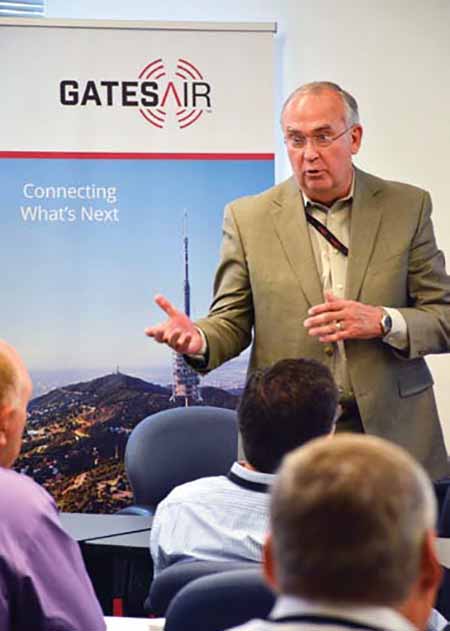GatesAir CEO Takes the Long View
QUINCY ILL.—The new CEO of GatesAir spent two decades of his career working as an executive in the oil and gas industry, where companies face billion-dollar decisions and where time “from concept to delivery”— from drilling an exploratory well to producing oil—can take more than a decade.

Phil Argyris became CEO of GatesAir in August. He joined former owner Harris Corp. in 2008.
GatesAir, formerly Harris Broadcast, has been through a lot of changes in the past couple of years, as have the radio and TV industries on which it is built. I was curious to hear from Phil Argyris (“AR-jir-riss”) how he views his company’s mission and outlook.
I found that, like many top executives in broadcast supply, he tends not to get caught in the day-to-day whirl of ups and downs, and professes a confident view of our industry’s long-term soundness.
TOGETHER BUT SEPARATE
In 2013, Harris Corp. divested its broadcast operations, and they were acquired by the Gores Group, a private investment firm. Subsequently, Gores separated the broadcast business into entities called Imagine Communications and GatesAir, with Charlie Vogt leading both as chief executive officer at first. Imagine Communications would focus on IP, software-defined networks, cloud and multiscreen technology while GatesAir, a wholly owned but separate operating company, would serve wireless, over-the-air content delivery for radio and TV broadcasters.
Last August, Vogt named Argyris to run GatesAir as CEO. Argyris holds an MBA in industrial relations and organization behavior from Temple University’s Fox School of Business Management and a bachelor of business administration in finance from Temple. He had worked in human resources with Amoco/BP from 1980 to 1999, then went to NCR Corp., where he was vice president of HR.
He joined Harris Corp. in 2003 and most recently held the position of VP/GM of transmission systems. His work for Harris/ GatesAir has included R&D, product line management and marketing roles.
The professional video industry's #1 source for news, trends and product and tech information. Sign up below.
WIRELESS DELIVERY
I asked Argyris how he defines the mission of GatesAir now.
“We’re still in the business of helping our customers drive the wireless delivery of content,” he told me by phone. “It’s not always a product delivery—you need to be building a solution for them—but as to our overall products, we’re a transmission company, primarily. Our mission is to drive over-the-air content with lower cost of ownership.”

GatesAir Maxiva VAX
While the company considers itself the world’s largest provider of radio transmitters and among the biggest providers of TV transmission, its products also create and transport content; it makes audio consoles, routing systems and audio distribution/ STLs as well as transmitters.
GatesAir and its 300 or so employees are not entirely separate from Imagine; Vogt continues to oversee it, and “we’re still finishing the carveout,” Argyris said. “We also have a relationship in cross-selling; we’re part of the Gores team. But independence is their direction. We’re 95 percent there. We’re on our own; I remind our team of that all the time.”
Manufacturing and service are centered in Quincy, Ill., while engineering and product lines are in Mason, Ohio, near Cincinnati.
Change has brought a different feel to the company, he said. Whereas former parent Harris Corp. focused largely on government business, “the speed at which we have to do things is really different. In our business at GatesAir, we have a more entrepreneurial view of things. And we don’t have to turn anywhere.” Important corporate decisions, he indicated, can be made in Quincy and Mason. His remarks echo what Chief Product Officer Rich Redmond told me earlier this year, that the company would be “a lot more nimble, focused, approachable.”
‘FANTASTIC MEDIUM’
When Harris Corp. announced its broadcast divestiture plans in 2012, I wrote that companies tend not to exit markets they feel are strong and growing. The subsequent price paid by Gores seemed low compared to prior broadcast acquisitions Harris had made, particularly in TV; so taken together, along with the growth challenges faced by all commercial broadcast manufacturers in recent years, I wondered about the overall health of the underlying market.
In its public statements, GatesAir has indicated that booms in both content and demand for content are good for radio and TV networks. Also, it sees opportunities in the digital conversions happening around the world, particularly in emerging countries, as well as in a likely “repack” of U.S. wireless spectrum. And executives, at GatesAir and elsewhere, have told me the global RF market is healthier than many in the United States might realize.
Argyris himself is emphatic: He is bullish about over-the-air broadcast.
“We have a fantastic medium in the radio and TV world to deliver content in a really inexpensive way, because of our one-to-many technology. Whether it’s DAB in Europe or HD Radio in the United States, we’ve been able to allow the broadcasters to increase the amount of content they can deliver.”
The combination of technology, new standards and a “huge” global listening/ viewing public is powerful, he said. As media evolve, broadcasters “are still an important piece of that formula. We were relevant 15 years ago, and we’re going to be relevant tomorrow.”
For instance, he said, “I had a conversation with four young people who described themselves as millennials. They describe how they cut the cord after growing up in a cable/satellite environment; they told me how they watch over-the-air TV as well as the Internet on demand.” The broadcast business, he said firmly, is viable. “I’m excited about it.”
Repack Summit Attracts Industry Experts
CINCINNATI — GatesAir recently summoned nearly 100 industry thought leaders and experts to its Mason, Ohio, headquarters for the company’s second Repack Summit. The two-day event addressed the concerns and challenges of U.S. broadcasters as they prepare for a variety of uncertain scenarios and exciting new opportunities.
The Repack Summit 2014 facilitated a dialog between broadcasters, the FCC, NAB, ONE Media and industry vendors including GatesAir, Dielectric and ERI. Executives and engineers from Cox Media, Cordillera Communications, Hearst-Argyle Television, Raycom Media and Sinclair Broadcast Group were among those in attendance, representing many of the industry leaders in U.S. TV broadcasting.
“There are still way more questions than answers about what’s coming down the road, what we may or may not be forced to do, and what our options are as broadcasters,” said Andy Suk, vice president of technology, Cordillera Communications. “This event was significant in that it created a great deal of dialogue across key industry figures, leading suppliers and representatives from the FCC. GatesAir needs to be commended for putting together this event and get some reality behind what is happening. It presents a real opportunity to our industry, especially as we look forward to ATSC 3.0 and other emerging opportunities.”

Jay Adrick, consultant to GatesAir
The event opened with presentations from GatesAir and the FCC. Martyn Horspool, TV transmission product manager at GatesAir, first discussed UHF channel change planning and weighed options for RF plant investment, including how broadcasters can accelerate ROI through new high-efficiency transmitters versus major modifications of the end-to-end RF infrastructure.
Pamela Gallant, associate division chief of the video division, media bureau for the FCC, followed with an in-depth look at the FCC’s reimbursement program for broadcasters affected by spectrum repack and new channel assignments. Additionally, two NAB thought leaders—Sam Matheny, executive vice president and CTO, and Victor Tawil, an NAB engineer—explored various transition scenarios as broadcasters prepare for ATSC 3.0 in the midst of the repack.
Day Two focused on next-generation opportunities for mobile convergence and the spectrum repack. Kevin Gage, executive vice president and CTO of ONE Media, opened the day with a discussion on eliminating the technical limitations of conventional mobile TV standards. Gage pointed to examples of next-generation broadcast platforms and standards that provide strong opportunities to effectively penetrate the mobile device marketplace.
GatesAir technology advisor Jay Adrick followed with a presentation on the latest events surrounding the U.S. spectrum repack. A highly respected expert in FCC matters as they relate to over-the-air broadcasting, Adrick delivered a summary of key points in the FCC’s Report & Order on the spectrum auction—notably, how stations should prepare for the spectrum repack along with a timeline of events.
Joe Seccia, manager, TV transmission market and product development strategy at GatesAir, closed the event with a look at how mobile convergence can drive new business opportunities for broadcasters. This included a detailed examination of GatesAir’s LTE Mobile Offload solution for transmitting LTE-compliant TV signals to tablets and smartphones.
“Collectively, the innovative minds of our industry have an opportunity to influence the future direction of over-the-air broadcasting,” said Phil Argyris, CEO, GatesAir. “Our second Repack Summit proved a beneficial educational experience for everyone involved, offering realworld solutions to existing business and technology challenges; and exploring new opportunities in mobile convergence and next-generation standards that will advance the future of TV.”
Bob Kovacs
POWER EFFICIENCY AND TCO
Expect the company to continue its emphasis on power efficiency and the concept of total cost of ownership, a financial term that helps buyers and sellers calculate both direct and indirect costs. For Argyris, TCO goes beyond transmitter specifications to overall use of the spectrum.
As an example on the video side, he pointed to the GatesAir LTE Mobile Offload project.
This technology, developed by the Institute for Communications Technology at the Technical University of Braunschweig in Germany, uses broadcasting to supplement mobile network bandwidth. If mobile network operators could offload video content to “high-tower, high-power” transmitters from GatesAir, the thinking goes, operators can reduce network congestion. The system is for the DVB-T2 broadcast standard used in Europe and elsewhere; GatesAir is working with the university to commercialize it and views the concept as a natural progression for UHF broadcasting.
IP infrastructure demand continues to be strong, Argyris said; and HD Radio provides opportunities, too. “As a business decision, is it a slam dunk?” he said of HD Radio. “No, but do I see movement? Yes. We have a good business.” He senses opportunities for smaller stations and “fill-ins” to invest, for instance, and thinks HD Radio technology eventually may help bring more services to station offerings.
But he doesn’t expect to see global radio consolidating around HD Radio or any one digital standard anytime soon. “There’s too much invested in DAB in Europe. DRM has been a long-time standard but slow to take off; China has its own standard. For right now, I think that [global standard] train has left the station.” Similarly, he doubts that a global TV standard is ahead anytime soon.
I’d also heard that uncertainty over U.S. spectrum auctions had caused a slowdown in TV RF spending, so I asked him about that.
“It depends on your timeframe,” he replied. “We went through a massive amount of work for the [TV] analog shutoff; after that, things slowed.” Over the past year and a half, TV equipment buyers hesitated, “but right now we’re seeing some things pick up” as older infrastructure ages and as users pursue more efficient investments. While television “won’t make a massive move” until the spectrum repack is worked out, he said, “I have seen positive movement.”
Argyris, who moved abroad to work in oil and gas at age 30, knows every geographical region differs, as do the technical challenges from industry to industry.
But although petroleum infrastructure projects involved, as he put it, “a lot more zeroes,” businesses are businesses; you have to understand your clients.
“We’re here to stay. We plan on being an industry innovator. We do those things by listening to our customers.”
Bob Kovacs is the former Technology Editor for TV Tech and editor of Government Video. He is a long-time video engineer and writer, who now works as a video producer for a government agency. In 2020, Kovacs won several awards as the editor and co-producer of the short film "Rendezvous."

